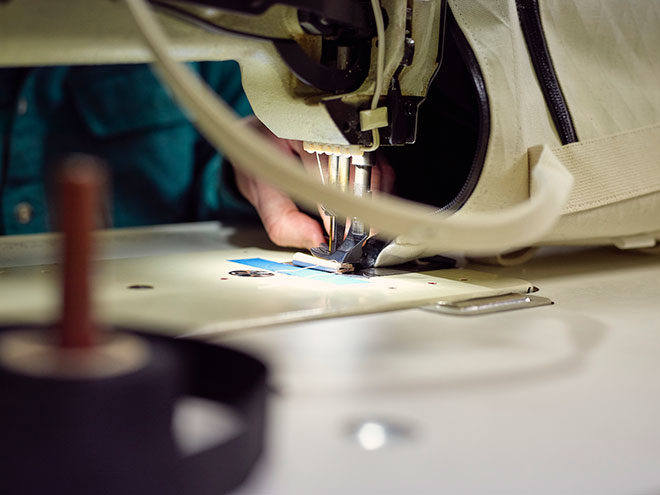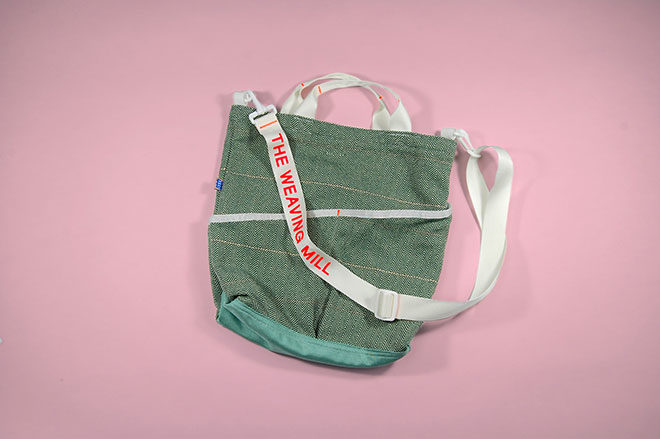Chicago Cut and Sewn: Interview with 1733
Art. Function. Experimentation. Chicago-based carry brand 1733 isn’t the sort of brand you can pigeonhole into one sphere. Sewn in small batches, their gear focuses on quality in build and materials alike, with a refreshing willingness to embrace new fabric and color plays. Not to mention an awesome custom service too. We caught up with founder Phil Schade to find out more about the brand…

1733 was founded by yourself (an engineer), but your brother Tim (an artist) has been involved in a few different capacities over the years. Though he’s not involved in the day-to-day business currently, why did you decide to collaborate together and what inspired you to make bags and create a carry brand?
1733 started as an informal portfolio of projects I was working on as I taught myself to sew. At the beginning I was making mostly home goods—pillows, trivets, upholstery. The bags came a little later as I began to build up my skills on the sewing machine and get a better understanding of the materials I wanted to work with. Tim came out to Chicago in 2015 to help me turn that portfolio into a shop and 1733 into a brand. It was super useful in those early days to have someone to bounce ideas off of, flesh out a color palette for our first range of bags, and redesign the website. Tim also is responsible for the graphic design of 1733, his aesthetics inform all of our physical and digital branding.

How did you get into sewing and making bags? Are you self-taught? Inspired by a mentor?
I started teaching myself how to sew as a way to get back to working with my hands. In college I enjoyed my labs and design projects the most. After graduating I started working in data analysis and database design and lost my physical connection to the things I was working on. Sewing interested me because I was thinking about sneakers and shoe design a lot and thought it would be a good way to build up skills to one day make my own shoes. After learning on—and breaking—a couple of home machines with too-heavy material, I took an upholstery class to learn to use industrial walking foot sewing machines. I also learned some basics of bag design in that class. After completing the course I had the confidence to buy an industrial machine and began taking 1733 more seriously as a bag making business.

How many people are in the 1733 team? Do you all have specific roles or do you get involved with various tasks in the day-to-day running of the brand and creating gear?
1733’s staff consists of me and two recently added part-time sewers. All design, business operations, cutting, and about 80% of the sewing is done by me. I rely on my part-time employees when we have to complete large orders and I can batch sewing operations together for them. I also have them help me with finishing and packing for shipping orders. Managing and making sure there are tasks for them to work on has been a new challenge for me, since for the first four years of 1733, I was doing everything on my own.

Tell us about a typical day at 1733 HQ.
I wouldn’t say there is a “typical” day at 1733, mostly because the types and sizes of projects we work on vary widely. I show up at our 400sq ft studio around 9. A lot of the time a day starts with cutting fabric. The material and quantities of the style being made determines which of my many cutting tools I will use. These tools range from scissors, manual rotary cutters, and utility blades for single ply to electric rotary cutters and cutting machines that can handle several inches of fabric at once. Sewing is done on five different sewing machines that handle different material weights and operations. In between production stages I spend time answering emails, designing and pattern making, meeting clients, and packing and shipping orders.

Do you find any materials or components particularly challenging to work with? Do you have any particular materials you love working with?
The first collection of bags I made were neoprene tote bags. I was inexperienced and didn’t know that much about materials at the time—I just thought neoprene looked and felt cool. The thick and stretchy nature of neoprene makes it difficult to work with, and as I mentioned before, it ended up gumming up and overtaxing my first home machine. I still use it today in laptop sleeves and some padding applications but those qualities still make it harder to work with (even though my skills and tools have improved). Leather is another material that can be challenging, the variation in a hide can make it slower to cut and harder to account for stretch when being used with non-stretchy materials like woven nylons. It is also expensive and unforgiving if you make a mistake, so I tend to work slower when making bags with leather components. Shock cord is also a pain to work with if it needs to be sewn: the cores are very dense and round, which makes sewing through it an exercise in precision and patience.
I really like working with traditional woven nylons like the Cordura variants and packcloth. They are strong and stable, have beautiful colors and textures and a very minimal degree of stretch, which allows them to turn corners neatly. The cotton faced X-Pac fabric, known as X10, is another of my favorites. It combines the look and feel of a traditional cotton duck with the waterproof properties of Dimension Polyant’s laminate technology and the raised diamond grid makes it look really cool. I’ve been working with an 18oz cotton canvas recently as well that is quite heavy and thick but provides very rewarding results when sewn up.

You work with a really varied mix of materials. How do you source them? Do you have a local supplier or source fabrics from overseas? Do you pick up materials on your travels?
Location is not a consideration for me when sourcing materials—I am looking for the highest quality at the best price. I use something like 40 vendors for fabrics, trim, and hardware. Because of 1733’s size, I have to shop around a lot to find the suppliers that have the MOQs I need at the prices that make sense.
Chicago still has a small but vibrant textile manufacturing community so there are resources here that I like to use. In the Pilsen neighborhood, there is a 70,000sq ft warehouse called the Discount Textile Outlet that has racks upon racks of deadstock fabric that is purchased from closed mills or other fabric stores that are going out of business—most of my leather comes from here, as well as a fuzzy material I use on some fanny packs and pouches. I am also using a local supplier for cotton duck canvases. Finally, The Weaving Mill is a local artist-run industrial mill that makes their own fabric for blankets, bags, home goods, and clothes. I use off-cuts from their production to make bags that we sell together as a collaboration.


In my travels the best place I’ve found to buy special materials is a small leather supplier in Lewiston, Maine called Brettuns Village. It is a co-op owned by a handful of tanneries in New England and New York that sells their overstock of seconds quality leathers at very reasonable prices.
1733 offers a custom bag-making service. Have there ever been pieces you struggled with or failed to make? If so, how did you solve the problem or make things right with the customer?
Custom bag design is almost always a struggle. It is slow and expensive because the customer has an idea in mind (usually something with lots of special features), and I have to take that idea and turn it into something that I can actually sew together. Most customers don’t think too much about the sewing construction of a bag and how it can limit what you can do within the space of a seam or a bag. My preference at the moment is to make smallish feature changes or special color or material changes to my existing patterns as customer bags. Though occasionally there is a bag idea that speaks to me and I jump in head first to try to work it out for someone. I have found that working on a custom bag or feature for someone may force me to learn a new technique or think about sewing construction in a different way. Having this experience always benefits me down the line when I am working on new designs.

Do you have a particularly memorable custom piece that really stands out for you? For instance, a unique design or a piece that helped you hone your manufacturing techniques or learn new ones?
The custom bag that most stands out to me is a softshell padded violin bag I made. The customer wanted a tactical look so it was done up in black 1000D Cordura and had MOLLE webbing and a big loop panel for morale patches. The juxtaposition of the heavy military elements of the bag and the refined delicate nature of the instrument really appealed to my sense of humour.

What’s your favorite 1733 piece and why?
The Daily Tote is my favorite bag that we make. I love the X10 material and how well it integrates with the size, shape, and functionality of the design. It’s kind of a hybrid of a briefcase and purse which makes it feel very unisex and versatile to me. I’m excited to share some new special colorways that it will be coming out in later this fall and winter.

Where’s the most unexpected place one of your bags has cropped up in? Perhaps a customer took a 1733 bag on a wild adventure or you shipped a purchase to a far-flung destination you never expected to?
I don’t know if any place has been that unexpected, I ship bags around the world and I know people take my bags on trips everywhere. Honestly the most exciting thing to me is when I see a stranger on the bus with one of my bags. I usually don’t say anything to them but it makes my day to get a glimpse of a thing I’ve made out in the world, and to see that it’s being used and enjoyed.

What differentiates 1733 from its competition?
One thing that separates us from other small cottage manufacturers is our location in an urban environment. Since I live in a big city, and have lived in big cities for most of my life, that kind of bag usage has really informed my designs. Commuting by bike or public transit, and having to travel outside of the city to experience nature means that our bags have to be styled in a certain way. Teal ripstop and trampoline suspensions don’t really get it done on a crowded L train. I also want my bags to be versatile. I’ve never really been a person who likes (or can afford) lots of super specialized gear, so having a daypack that you can commute and hike and travel with is important to me. There are plenty of other brands who are going after these same ideas, but when you get down to the smaller brands like mine there is a lot more focus on specialized activities like thru-hiking and bike packing. I also think what makes 1733 unique from those other cottage brands is my willingness to incorporate multi-paned shapes and curved pattern pieces in my designs. It leads to more complex cutting and sewing operations but I think it contributes to both the form and function that I am striving for. Finally, another thing that distinguishes the brand is my interest in experimenting with different materials outside of the Cordura, Dyneema, and X-Pac range. Specifically in our collaborations we get to work with unique materials and treatments that are not seen in many other bags.
How do you choose collaborators to work with? Are there particular creative traits you look for or shared values?
I like to work with collaborators who have skills and perspectives that are different from mine. The best collaborative projects involve working closely with an artist or designer who values materials and construction like I do and we work together to puzzle out how to make our ideas into a real thing—thinking through all the steps and elements required to produce a finished product. Specifically, I love collaborations that involve the creation and use of custom textiles: I get super excited about weaving, printing, and dyeing because the end results are always so unique and have so much of a physical connection to the people who made them. My projects with Dog Pasta and The Weaving Mill represent this type of work well.



A clear vision is also a refreshing trait in a collaborator. The NOAHZAGOR bags I made using incredible mid-century Japanese shibori fabrics, and the first run of bags I made for Meridian, where I used materials from the ultralight hiking world, both started as proposals with a strong idea for me to work from and add to. The fun (and challenging) part is figuring out how to take elements of each of our styles and practices to make something new.


What business advice would you share with others looking to start a carry brand? Are there things you wish you’d done differently or mistakes that taught you a lot?
I do not have any sage “business” advice that I think is particularly helpful, or that can be easily generalized. Trying to manufacture in-house, at scale, is very difficult, but I haven’t yet found another way to do it while maintaining the control I feel I need to have a product that meets my design and quality standards. I think the most important thing I can impart to other people trying to make carry goods is to do something unique. Does the world need another rounded-corner rectangle travel bag?
How do you stay inspired to keep creating new gear?
I just think about bags, materials, and sewing all the time. When I’m at the airport, or on the street, I’ll just be looking around to see what people are using, and I’m constantly reading about new and old gear. My girlfriend is an amazing wear tester, she abuses her bags by over-stuffing them and never cleaning them out. Seeing how she uses the bags I make for her, I always find something I can improve or a new design that would be more effective. Often, a concept pops into my head that I think might be worth trying. If it’s something simple I might set aside an afternoon to make a prototype to start testing. If it’s more complex I’ll keep thinking about it and sketching it and trying to figure out how it could be assembled. If it sticks in there long enough I know I should give it a go, and I try to find some time to start patterning and sewing. In my view, knowing how to sew and put things together is a very important skill for a designer. Being mostly self-taught has allowed me to iterate 1733 as a brand in a way that feels cohesive and progressive.

Have you got any current projects you’re excited to share with us? Or fun design projects on the horizon?
At the moment I’m most excited for the second round of bags that will be produced for the store Meridian in Hudson, NY. When I describe working with Sam to other people I like to say that he “gets it.” I don’t know how else to put it but he pushes me creatively, gives me extremely useful feedback, and trusts me to design and make what are going to be some very special pieces. We should be releasing the collection this November. A bit further down the line I want to keep iterating a new design of a bag called the Trek Pack, which will be a 25-35ish-liter travel and hiking backpack which takes some inspiration from the thru-hiking world.






 Carry Awards
Carry Awards Insights
Insights Liking
Liking Projects
Projects Interviews
Interviews















